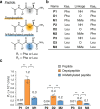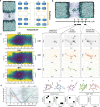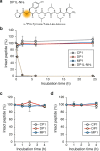Amide-to-ester substitution as a stable alternative to N-methylation for increasing membrane permeability in cyclic peptides
- PMID: 36932083
- PMCID: PMC10023679
- DOI: 10.1038/s41467-023-36978-z
Amide-to-ester substitution as a stable alternative to N-methylation for increasing membrane permeability in cyclic peptides
Abstract
Naturally occurring peptides with high membrane permeability often have ester bonds on their backbones. However, the impact of amide-to-ester substitutions on the membrane permeability of peptides has not been directly evaluated. Here we report the effect of amide-to-ester substitutions on the membrane permeability and conformational ensemble of cyclic peptides related to membrane permeation. Amide-to-ester substitutions are shown to improve the membrane permeability of dipeptides and a model cyclic hexapeptide. NMR-based conformational analysis and enhanced sampling molecular dynamics simulations suggest that the conformational transition of the cyclic hexapeptide upon membrane permeation is differently influenced by an amide-to-ester substitution and an amide N-methylation. The effect of amide-to-ester substitution on membrane permeability of other cyclic hexapeptides, cyclic octapeptides, and a cyclic nonapeptide is also investigated to examine the scope of the substitution. Appropriate utilization of amide-to-ester substitution based on our results will facilitate the development of membrane-permeable peptides.
© 2023. The Author(s).
Conflict of interest statement
The authors declare no competing interests.
Figures






Similar articles
-
Amide-to-ester substitution allows fine-tuning of the cyclopeptide conformational ensemble.Angew Chem Int Ed Engl. 2010 Apr 1;49(15):2732-7. doi: 10.1002/anie.200907274. Angew Chem Int Ed Engl. 2010. PMID: 20213784 No abstract available.
-
Amide-to-Ester Substitution as a Strategy for Optimizing PROTAC Permeability and Cellular Activity.J Med Chem. 2021 Dec 23;64(24):18082-18101. doi: 10.1021/acs.jmedchem.1c01496. Epub 2021 Dec 9. J Med Chem. 2021. PMID: 34881891 Free PMC article.
-
The effect of multiple N-methylation on intestinal permeability of cyclic hexapeptides.Mol Pharm. 2011 Apr 4;8(2):479-87. doi: 10.1021/mp1003306. Epub 2011 Mar 21. Mol Pharm. 2011. PMID: 21375270
-
Improvement on Permeability of Cyclic Peptide/Peptidomimetic: Backbone N-Methylation as A Useful Tool.Mar Drugs. 2021 May 27;19(6):311. doi: 10.3390/md19060311. Mar Drugs. 2021. PMID: 34072121 Free PMC article. Review.
-
Probing Backbone Hydrogen Bonds in Proteins by Amide-to-Ester Mutations.Chembiochem. 2018 Oct 18;19(20):2136-2145. doi: 10.1002/cbic.201800350. Epub 2018 Oct 1. Chembiochem. 2018. PMID: 30073762 Review.
Cited by
-
CycPeptMP: enhancing membrane permeability prediction of cyclic peptides with multi-level molecular features and data augmentation.Brief Bioinform. 2024 Jul 25;25(5):bbae417. doi: 10.1093/bib/bbae417. Brief Bioinform. 2024. PMID: 39210505 Free PMC article.
-
Nature-Inspired Gallinamides Are Potent Antischistosomal Agents: Inhibition of the Cathepsin B1 Protease Target and Binding Mode Analysis.ACS Infect Dis. 2024 Jun 14;10(6):1935-1948. doi: 10.1021/acsinfecdis.3c00589. Epub 2024 May 17. ACS Infect Dis. 2024. PMID: 38757505 Free PMC article.
-
Peptide design to control protein-protein interactions.Chem Soc Rev. 2025 Feb 17;54(4):1684-1698. doi: 10.1039/d4cs00243a. Chem Soc Rev. 2025. PMID: 39817557 Free PMC article. Review.
-
Isolation, total synthesis and structure determination of antifungal macrocyclic depsipeptide, tetraselide.Chem Sci. 2025 Mar 4;16(14):6060-6069. doi: 10.1039/d5sc00566c. eCollection 2025 Apr 2. Chem Sci. 2025. PMID: 40070467 Free PMC article.
-
Mixture-Based Screening of Focused Combinatorial Libraries by NMR: Application to the Antiapoptotic Protein hMcl-1.J Med Chem. 2023 Jul 27;66(14):10108-10118. doi: 10.1021/acs.jmedchem.3c01073. Epub 2023 Jul 18. J Med Chem. 2023. PMID: 37464766 Free PMC article.

